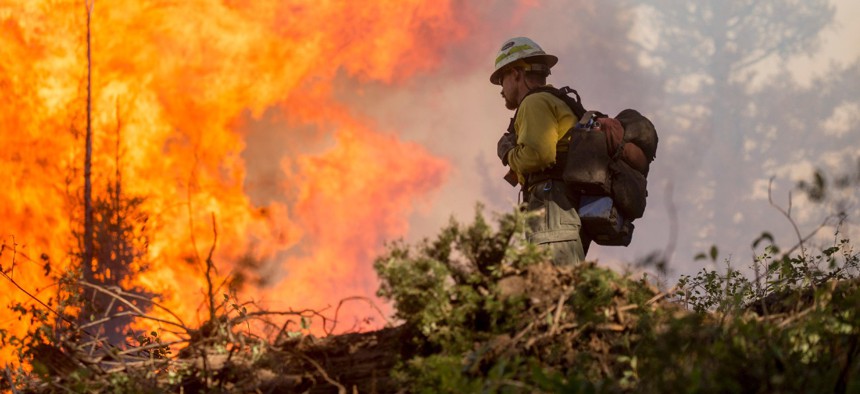
Firefighters work on the Pioneer Fire in the Boise National Forest in 2016. U.S. Forest Service file photo
Union Urges Further Action to Improve Firefighter Pay
A weekly roundup of pay and benefits news.
A federal employee union last week urged President Biden to follow up on his recent efforts to boost the pay of federal firefighters to at least $15 per hour this year and institute a number of changes to improve their pay, benefits and quality of life.
Earlier this month, Biden announced that this year, permanent firefighters paid at a GS-9 level or below will receive a 10% retention incentive, while temporary employees will receive a $1,000 Spot/Star award in order to boost their pay from around $13 per hour to $15, the figure he and other Democrats have urged to be the national minimum wage. The administration also announced that the U.S. Forest Service and the Interior Department have been granted a waiver to extend seasonal employees’ terms so they can work additional hours, and both agencies will engage in hiring sprees, taking on new workers and converting seasonal employees to full-time status.
In a letter to the president last week, National Federation of Federal Employees National President Randy Erwin highlighted additional steps that the administration can take without congressional action to improve the lives of the tens of thousands of federal firefighters his union represents.
Although Biden has stated he intends to seek a long-term solution to federal firefighters’ low pay through legislation in Congress, Erwin said the government could boost salaries by up to 50% through a variety of administrative actions, including creating a new job classification and series of positions for firefighters, baking hazard pay into their regular salaries so that it is reflected in their leave and retirement benefits, and providing remote location pay for those who travel away from their families to work during fire season.
“Approximately half of federal firefighter income comes in the form of overtime and hazard pay, all of which is excluded from wages considered for retirement,” Erwin wrote. “Our members are paid far less than the state and local firefighters they work alongside. Our agencies provide some of the best training and experience, but many experienced firefighters leave once they get to journeyman level for better pay elsewhere, from $21 an hour up to triple that. Pay increases will improve workforce retention, which saves on training costs and ensures we have the most experienced hands on the fire line.”
Erwin also lauded the administration’s short-term plan to hire and convert seasonal employees to full-time status as a good “first step,” but said the agencies that employ federal firefighters must increase their ranks by 10,000 to 20,000 over the next decade to ease the strain felt by the current workforce. He urged the administration to hire more permanent seasonal employees, to convert temporary hires to permanent seasonal status, and to boost funding to ensure employees who have their hours extended are guaranteed employment through the duration of that extension.
“Year-round employment may also mean year-round deployment, which potentially deprives our firefighters of critical off-season recovery time from fatigue and the stress of the job,” Erwin wrote. “Please hire more firefighters before asking more of our already stretched workforce.”
Also key to dealing with the increased workload of a longer fire season will be improving federal firefighters’ access to mental health resources and other work-life balance programs, Erwin wrote. He encouraged agencies to improve firefighters’ employee assistance program to include specialists with experience working with first responders, require agencies to allow regular work schedules during slower periods, and stagger workers’ schedules more efficiently.
“Many of our firefighters have witnessed their colleagues injured or killed on the job and have experienced their own close calls,” Erwin wrote. “We need a new program that is fully accessible in rural areas; staffed with professionals who know trauma and treat PTSD, depression and substance abuse; and includes comprehensive suicide prevention and crisis support.”







